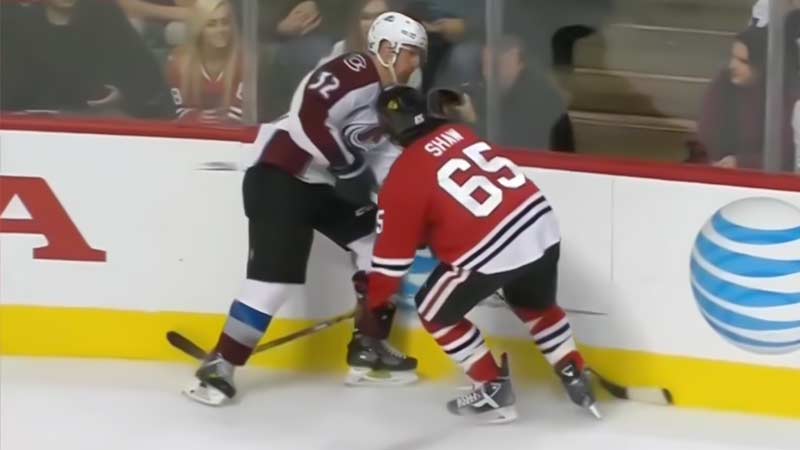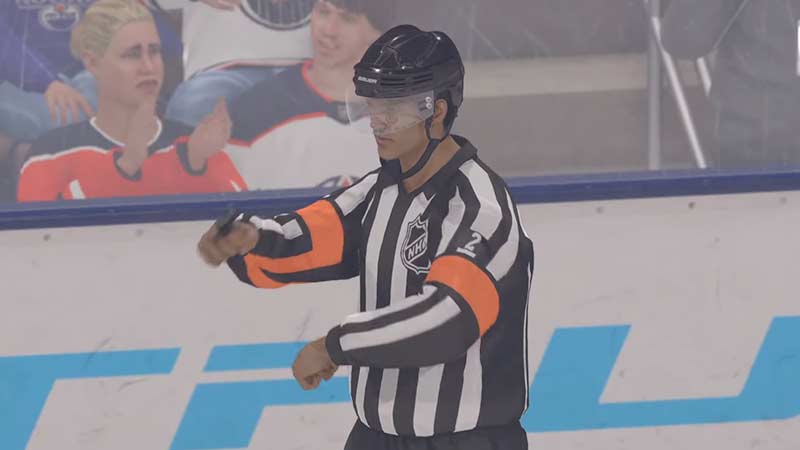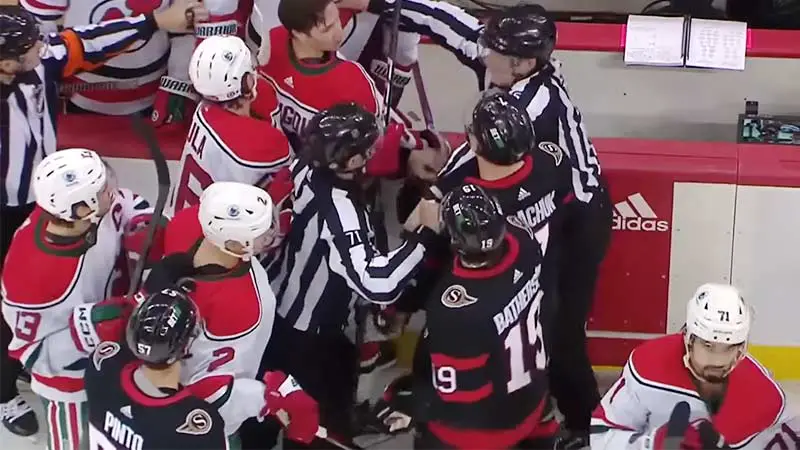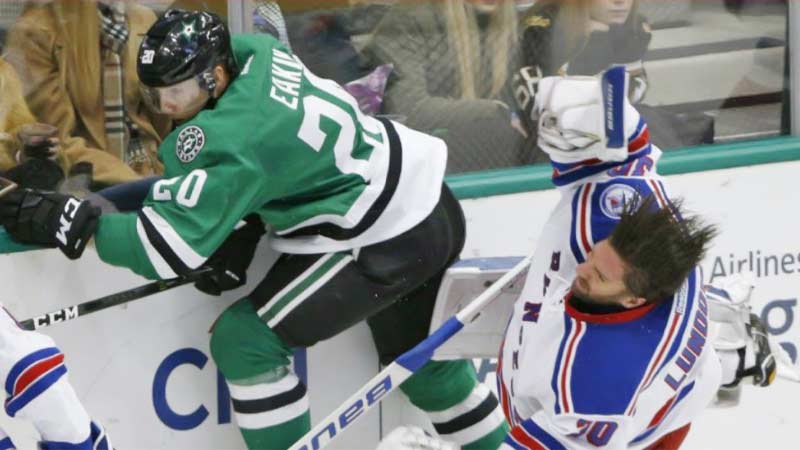Hockey enthusiasts often witness the intense physicality of the game, with players engaging in strategic maneuvers and forceful checks.
Among the regulations governing player conduct, “charging” stands out as a pivotal aspect that influences the dynamics of play and player safety.
In this comprehensive guide, we delve into the intricacies of what is charging in hockey.
From understanding the key factors that contribute to charging penalties to debunking common misconceptions, this exploration aims to provide a nuanced perspective on the role of charging in the sport.
Whether you’re a passionate fan, a player seeking clarity on the rules, or an aspiring referee, this guide is your go-to resource for unraveling the complexities of charging in hockey. So, stay sharp.
What Is Charging in Hockey?
In hockey, “charging” refers to a penalized action where a player aggressively accelerates towards an opponent and forcefully checks them with excessive and deliberate force.
This infraction is typically committed when a player takes more than a few strides before delivering a hit, and the hit itself is characterized by its violent nature.
Charging is penalized to ensure player safety and maintain a fair and controlled playing environment.
The specific rules regarding charging may vary slightly between different hockey leagues, but common elements include the number of strides taken before the hit and the severity of the impact.
The penalty for charging usually results in the offending player being sent to the penalty box for a set amount of time, leaving their team shorthanded.
Rules and Regulations of Charging in Hockey

Charging in hockey is a penalized action aimed at maintaining player safety and fair play. It involves a player aggressively accelerating toward an opponent and delivering a forceful check with excessive and deliberate force.
Understanding the rules and regulations surrounding charging is crucial for players, coaches, and officials to ensure the integrity of the game.
Number of Strides
Charging penalties often hinge on the number of strides a player takes before making contact with the opponent.
Typically, exceeding the acceptable stride limit, usually defined by the league’s rules, constitutes charging.
This rule aims to prevent players from building up excessive speed before delivering a hit.
Intent and Force
The rules consider both intent and force when assessing charging infractions. Players are penalized not only for the number of strides but also for the aggressive nature of the hit.
Deliberate and forceful checks that put opponents at risk of injury are likely to result in charging penalties.
Player Positioning
Charging regulations may also take into account the position of the player making the hit and the player being hit.
If a player charges from a considerable distance or in a manner that catches the opponent off guard, it increases the likelihood of a penalty. Fair play standards require players to be mindful of their opponents’ positions.
Puck Possession
Charging penalties may be influenced by whether the player being hit has possession of the puck.
Charging an opponent without possession may be penalized more severely as it is considered an unnecessary and potentially dangerous action that doesn’t contribute to the natural flow of the game.
Penalty Consequences
Incurring a charging penalty results in the offending player serving time in the penalty box, leaving their team shorthanded.
Additionally, repeat offenses or particularly dangerous charges may lead to more severe disciplinary actions, including fines or suspensions.
The strict enforcement of charging rules underscores the commitment to player safety within the sport.
Key Factors in Hockey Charging

Understanding the key factors in hockey charging is essential for players and officials alike to maintain a safe and fair playing environment.
Charging is a penalized action in hockey where a player aggressively accelerates toward an opponent and delivers a forceful check with excessive and deliberate force.
The following factors shed light on crucial aspects that contribute to the identification and assessment of charging incidents.
Speed and Stride Length
One of the primary factors in charging is the speed at which a player approaches an opponent and the length of the strides taken.
Excessive speed and an extended number of strides can escalate the impact of a check, leading to a charging penalty.
Leagues often establish specific guidelines regarding acceptable speed and stride length to maintain a balance between competitiveness and safety.
Distance and Timing
The distance between the charging player and the opponent, combined with the timing of the hit, plays a critical role.
Charging penalties may be more likely if a player closes in on an opponent from a considerable distance or if the hit is poorly timed, catching the opponent off guard.
Proper timing and spatial awareness are essential to avoid unnecessary and potentially dangerous checks.
Player Position and Vulnerability
Charging penalties are influenced by the position of both the player delivering the hit and the player receiving it.
Charging an opponent who is in a vulnerable position, such as along the boards or with their back turned, increases the likelihood of a penalty.
Players are expected to exercise caution and avoid hits that may cause harm to opponents in compromised positions.
Force and Impact
The force and impact of the check are integral factors in determining the severity of a charging penalty.
Deliberate and excessively forceful hits that put an opponent at risk of injury are likely to result in stricter penalties.
Leagues emphasize the importance of fair play and discourage actions that compromise the safety of players on the ice.
Possession of the Puck
Whether the player being hit has possession of the puck is another key factor in charging incidents.
Charging an opponent without possession of the puck is often viewed as an unnecessary and potentially dangerous action, as it does not contribute to the natural flow of the game.
Charging penalties may be more severe in such situations to discourage unproductive aggression.
Impact of Charging in Hockey

Charging in hockey can have significant repercussions, impacting both individual games and the broader sport.
This penalized action, characterized by an aggressive approach and forceful check, not only influences the dynamics of a particular play but also raises concerns about player safety and the overall integrity of the game.
Player Safety and Injury Risk
One of the most immediate impacts of charging is the heightened risk of injuries to players.
The forceful nature of a charging hit, especially when delivered recklessly or with excessive aggression, can lead to serious injuries such as concussions, sprains, or fractures.
Prioritizing player safety is paramount, and charging penalties aims to mitigate the potential harm caused by overly aggressive plays.
Game Momentum and Team Dynamics
Charging penalties can disrupt the flow of a game and alter its momentum. When a player is penalized for charging, their team is forced to play shorthanded, creating an advantage for the opposing team.
This imbalance can shift control of the game and affect team dynamics, requiring strategic adjustments and potentially impacting the final outcome.
Referee Decision and Fan Perception
The referee’s decision regarding charging incidents can influence the perception of the game by both players and fans.
Consistent enforcement of charging rules contributes to a fair and just competition, ensuring that all players adhere to the same standards of conduct.
Inconsistent calls or perceived leniency may lead to frustration among players and affect the fans’ confidence in the integrity of the officiating.
Disciplinary Consequences
Charging incidents can have disciplinary consequences beyond the immediate game.
Repeat offenses, particularly those involving blatant disregard for player safety, may lead to fines, suspensions, or other disciplinary actions imposed by the league.
Such measures reinforce the importance of responsible play and discourage players from engaging in reckless behavior on the ice.
League Emphasis on Player Welfare
Charging incidents prompt leagues to continually reassess and refine rules and regulations to enhance player safety.
The impact of charging extends beyond individual games, prompting ongoing discussions and initiatives aimed at creating a safer playing environment.
Leagues may implement rule changes, educational programs, or technological advancements to minimize the risk of injuries associated with charging.
Common Misconceptions Regarding Charging in Hockey
Charging in hockey is a nuanced aspect of the game, often susceptible to misconceptions that can impact player behavior, officiating decisions, and overall understanding of the rules.
Dispelling these misconceptions is crucial for fostering a more accurate and informed perspective on charging and its role in the sport.
Misinterpretation of Speed
A common misconception involves the interpretation of speed when assessing charging penalties.
It’s essential to recognize that charging is not solely determined by a player’s overall speed but rather by excessive acceleration and an unwarranted, forceful hit.
Understanding the difference helps in more accurately identifying charging infractions and promoting fair play.
Assumption of Intent
Misunderstandings often arise concerning the intent behind a player’s actions.
Charging penalties are not solely based on the intent to injure; they can also be applied when a player’s aggressive approach poses a risk to opponents.
Recognizing that intent and impact both contribute to charging calls is crucial to avoid misconceptions about a player’s motives.
Puck Possession as a Definitive Factor
Some may incorrectly assume that a player can only be charged if they have possession of the puck.
However, charging penalties can still be warranted if a hit is deemed excessively aggressive or dangerous, even when the targeted player doesn’t have possession.
Understanding that puck possession is not the sole criterion for charging prevents oversimplification of the rule.
Belief in Consistent Calls Across Leagues
There’s a misconception that charging penalties are consistently called in the same manner across all hockey leagues.
In reality, different leagues may have slight variations in how they interpret and enforce charging rules.
Acknowledging these distinctions is crucial for players, coaches, and fans to comprehend the specific standards upheld within a particular league.
Overemphasis on Body Checking
Charging is distinct from regular body checking, yet there’s a common misconception that any forceful hit constitutes charging.
Body checking within the bounds of the rules is a fundamental aspect of hockey, but charging specifically refers to hits that involve excessive speed and force.
Recognizing this distinction helps in accurately differentiating between legal and penalized hits.
Addressing these misconceptions enhances the overall understanding of charging in hockey, contributing to fairer play, improved officiating decisions, and a more informed appreciation of the rules governing player conduct on the ice.
FAQs
What is charging in hockey?
Charging in hockey refers to a penalized action where a player aggressively accelerates toward an opponent, taking excessive strides, and delivers a forceful check.
The goal is to maintain player safety and ensure fair play by penalizing overly aggressive and potentially dangerous hits.
How is charging determined by referees?
Referees assess charging based on factors like excessive speed, the number of strides taken, forcefulness, and the impact on the opponent.
It’s a judgment call, considering the player’s intent and the potential risk of injury to maintain a balance between competitiveness and safety.
Can a hit be considered charging if the player has the puck?
Yes, a hit can still be considered charging even if the player has the puck.
Charging penalties focus not only on puck possession but also on the aggressive and potentially dangerous nature of the hit. Players are expected to avoid unnecessary force, regardless of possession.
Are there specific rules regarding charging in different hockey leagues?
Yes, specific rules regarding charging may vary between hockey leagues. While the fundamental principles are similar, leagues may have slight variations in how they define and enforce charging penalties.
Players and officials should be aware of and adhere to the specific charging regulations within their respective leagues.
What are the consequences of a charging penalty?
The consequences of a charging penalty include the offending player serving time in the penalty box, and leaving their team shorthanded.
Repeat offenses or particularly dangerous charges may lead to additional disciplinary actions, such as fines or suspensions.
The strict enforcement of charging rules aims to prioritize player safety within the sport.
Wrapping Up
Charging in hockey transcends mere penalized actions; it is a fundamental element shaping the game’s ethos.
Through a lens of player safety, fair play, and strategic dynamics, this guide aimed to demystify the concept of charging.
As players continue to navigate the ice with calculated aggression, and referees make split-second judgments, an informed understanding of charging ensures a harmonious blend of competitiveness and safety within the thrilling realm of hockey. Thank you so much.








James Felix